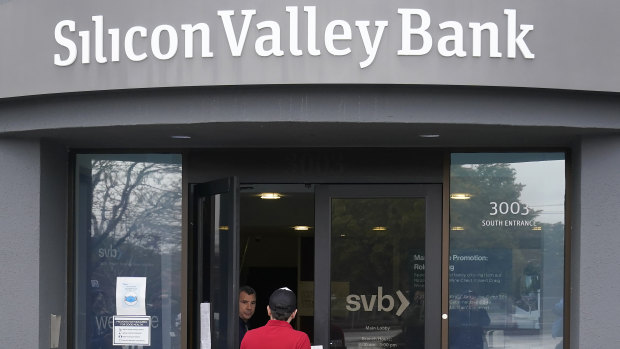This was published 2 years ago
‘Incredibly hard to see’: Investors play down SVB contagion fears
Australian investors say the dramatic collapse of Silicon Valley Bank is unlikely to spark systemic problems for global banking markets, but its failure will rattle sharemarket confidence.
Local bank watchers also highlighted fundamental differences between SVB and Australia’s banking industry, arguing the combination of forces that brought down the US lender are highly specific.

Authorities shut down Silicon Valley Bank late last week.Credit: AP
SVB, which mainly served technology businesses, collapsed at the weekend. It was the second-largest US bank failure in the nation’s history. The final trigger for the sudden failure was a run as clients sought to withdraw billions in deposits, prompting the US government to step in over the weekend and take control of the lender.
On Monday morning, sharemarket fears surrounding the bank failure’s broader impacts appeared to abate significantly, after the US government said no depositors would lose money. In early trading, the ASX was 0.5 per cent lower.
Meanwhile, banking experts and fund managers highlighted specific characteristics of SVB, in particular its narrow focus on US technology businesses as clients; its large exposure to bonds; and differences in US and Australian banking regulation.
Principal at fund manager Alphinity Andrew Martin pointed SVB’s concentrated customer base in the tech sector, and the fact that an unusually large share of its assets were bonds, rather than bank loans. As squeezed tech businesses started withdrawing their deposits, SVB was forced to sell a $US21 billion bond portfolio at a $US1.8 billion loss last week.
Martin said this was a “very specific circumstance” that applied to SVB. “It’s incredibly hard to see – other than if it causes lower confidence in the system and people start running on other banks – how it’s a systemic issue on its own,” Martin said.
Portfolio manager at Tribeca Investment Partners, Jun Bei Liu, also said she did not think the collapse signalled broader problems in the world banking system, though she said the size of the collapse was “scary” and this had spooked the market late last week.
“I think the contagion effect is very, very limited. It seems like the problems are very company-specific,” Liu said.
Morningstar banking analyst Nathan Zaia said he did not expect the failure in itself to set off wider fears for financial stability. “I think one bank blowing up on its own is not necessarily that big a deal [for financial stability]. A lot of the customers will just move to other bigger banks in that market,” Zaia said.
Managing director at White Funds Management, Angus Gluskie, said investment markets were likely to continue speculating over the potential fallout from the SVB collapse.
“Any time you get a bank collapse of this nature it may lead to further problems, but equally that is not necessarily the case. It just depends how much flow on occurs from this initial default and whether that cascades more fully through financial markets. If it’s contained, then it might be an incident with limited further ramifications,” he said.
Experts also pointed to fundamental differences between Australia’s banks and SVB: including the far greater diversification of Australian banks, their lower exposure to bonds, and different regulatory standards.
Martin said Australian banks used their deposits to fund lending, rather than investing in bonds, and regulations required lenders to adjust their capital if the market value of bonds fell. “It’s hard to see a situation that’s similar in Australia, in terms of the circumstances that affected SVB. It’s a different market, different system, different regulation,” Martin said.
Zaia also highlighted stark differences between Australian banks and SVB, saying Australian banks used conservative assumptions to test how their assets would be affected by rising interest rates. “They’ve already been increasing capital from those interest rate movements that we’ve had,” Zaia said.
The Australian Banking Association on Sunday night also highlighted the differences between SVB and Australia’s lenders, noting the US bank’s high exposure to technology companies.
“Australia’s banks in contrast are strong and subject to a different set of regulatory frameworks. ABA members are well diversified and therefore well positioned in the event that one sector experiences challenging financial circumstances,” the ABA said.
The Business Briefing newsletter delivers major stories, exclusive coverage and expert opinion. Sign up to get it every weekday morning.